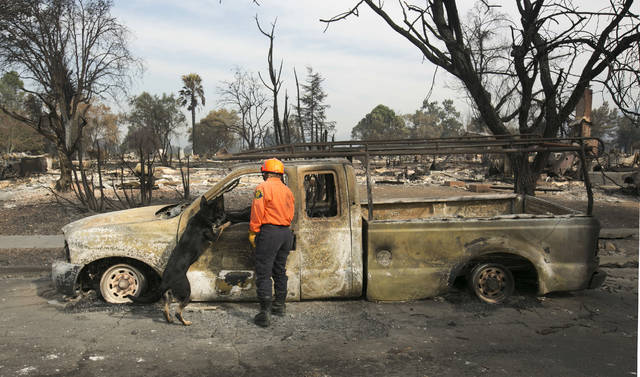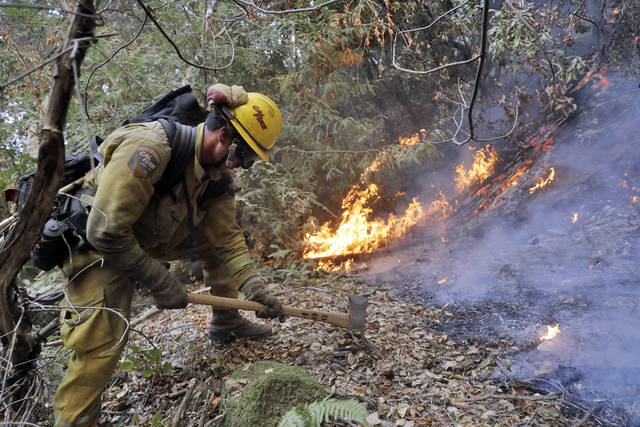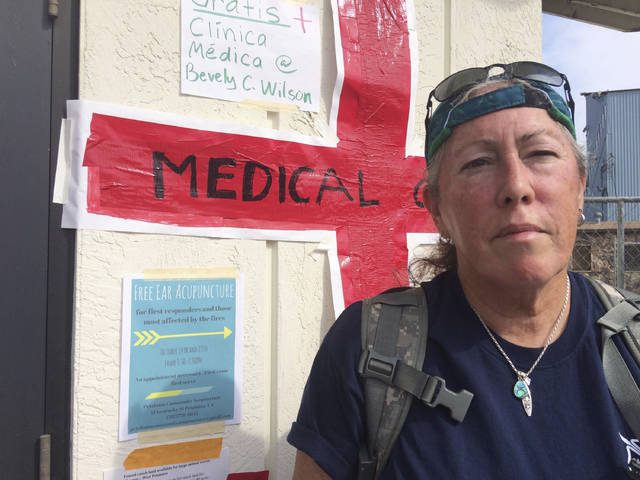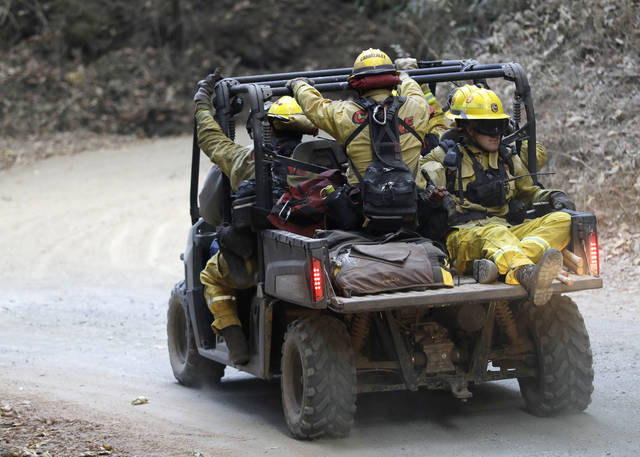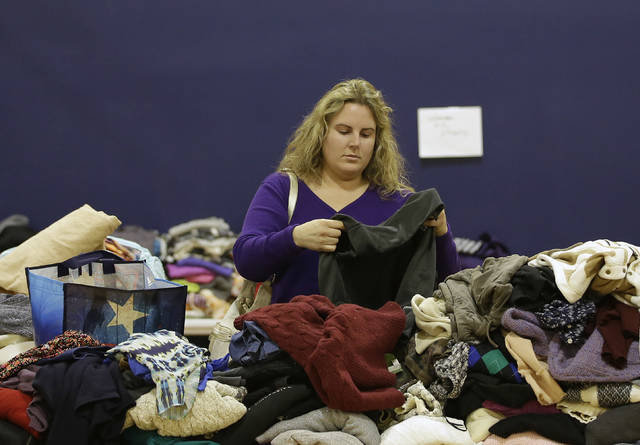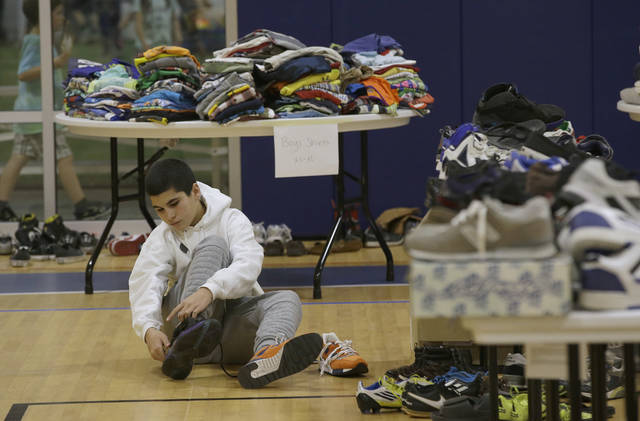Californians head back home to altered lives, communities
PETALUMA, Calif. — Some have lost loved ones. Many have survived near-death experiences. Others have lost their homes and a lifetime of possessions.
A week after fleeing raging wildfires, tens of thousands of emotionally ravaged Californians have drifted back home to find their lives and their communities dramatically altered.
At a Red Cross shelter in Petaluma on Tuesday, 69-year-old Sue Wortman recalled the words that raced through her mind when she fled the flames near her home in Sonoma.
“We’re all going up in smoke,” she thought at the time. Since then, she’s been walking around in a daze.
Firefighters gained more control Tuesday of the massive wine country wildfires, even as other blazes erupted in mountains near Los Angeles and Santa Cruz.
Meanwhile, officials and trauma experts worried about the emotional toll taken by the grueling week of blazes.
Wortman has been living in her RV outside the Petaluma shelter, while hundreds of other evacuees sought refuge in tents and trailers and on cots inside the fairground facility. She has sought comfort among friends and with her dogs but knows that feeling won’t last.
“I think it’s really going to hit when we go home and see the destruction,” she said.
Highlighting the concerns of mental health professionals, the California Psychological Association has emailed an urgent request calling for volunteers to help wildfire evacuees cope with the trauma they have faced and its aftermath.
“There is tremendous acute and long term impact and we are needed right now to help,” Dr. Chip Shreiber, the association’s disaster resource coordinator, said in the email sent Monday to a distribution list of 13,000 licensed psychologists across California. “Please get the word out.”
The fires that swept through parts of seven counties were the deadliest and most destructive series of blazes in California history. At least 41 people were killed and 6,000 homes destroyed.
On Tuesday, authorities identified the only firefighter to die in the blazes as 38-year-old Garrett Paiz of Missouri. He was killed Monday when a water transport truck he was driving rolled over near one of the wildfires in the Napa Valley community of Oakville.
An estimated 100,000 people were evacuated at the height of the fires, and about 34,000 remain under evacuation. Many have yet to find out if their homes are still standing.
“There’s still a lot of shock and numbness when you’re in the middle of it. You’re in the high-gear of trying to cope,” said Peggy Ledner-Spaulding, head of outpatient behavior health services at St Joseph’s hospital in Santa Rosa, one of the cities hardest-hit by the fires. “But now we’re starting to enter into the next phase, as they have control over the fires. That shock and disbelief starts to wear out, and we have a lot of stress and anxiety and grief and worry.”
It’s common for survivors to feel a range of emotions — sadness, anger, irritability — and to suffer flashbacks or nightmares while having trouble sleeping, especially in a shelter surrounded by strangers.
Physical reactions from the stress can include stomach aches and headaches, but many evacuees are reporting headaches and sore throats from the thick smoke still cloaking the area.
Evacuees were advised to pace their exposure to news and media, which provide information that can reduce anxiety but also become overwhelming. Talking and debriefing is helpful, and parents should encourage children to talk and express their fears, Ledner-Spaulding said.
Sonoma County Supervisor Shirlee Zane has advised anyone with a family member or loved one who has lost everything to accept that they can’t fix the damage but they can offer support.
“Provide a compassionate listening ear right now, and let them feel whatever they’re feeling,” said Zane, a former grief therapist.
Still, life will change for those who must rebuild from nothing.
“It’s never going to be the same,” said Rob Brown, a supervisor in Mendocino County, where all 8,000 evacuees have been cleared to go home. “You’re going to have to seek a new normal.”
“You’ll see benefits within years,” Brown said. “But you’re literally in for decades of recovery.”
At the Petaluma shelter, signs advertised a stress management class and group. A welcome table at the medical clinic had handout literature from the American Psychological Association about dealing with the emotional toll of a disaster or traumatic event.
Michelle Patino, a nurse in Santa Rosa who volunteered at the shelter’s medical clinic, said she saw people who appeared to be experiencing mental breakdowns and a woman so despondent she threatened suicide.
“You have people who are emotionally displaced,” she said.
Lynn Bufka, a psychologist and an associate executive director at the Washington, D.C.-based American Psychological Association, said a sense of community can help with healing and recovery but that isn’t possible in some neighborhoods that vanished into ashes.
“The sense of community has burned to the ground as well,” Bufka said.
She advised evacuees to focus on the positives of what is left — family, friends, health. But as with war veterans, the symptoms of trauma or depression sometimes don’t surface for months or years, she said.
But keeping positive is hard when facing the reality of starting from scratch, said John De Groot, whose home in Santa Rosa burned down along with a lifetime of memories.
“You’re filled with anxiety in terms of what is going to happen,” said De Groot, who lined up at an assistance center for victims in Santa Rosa. “I’m not 22 anymore. We’ve worked our whole lives. We’ve had this house for 23 years. So there are a lot of memories there. Grandkids have been there. They love it. And it’s not there. So now what?”
___
Associated Press writers Ellen Knickmeyer in Sonoma, Terry Chea in Santa Rosa, Janie Har in San Francisco, Andrew Dalton and Christopher Weber in Los Angeles contributed to this report.


